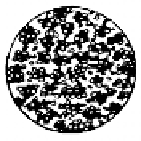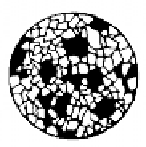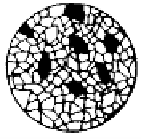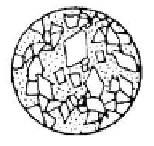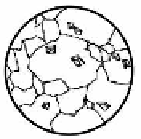Geology Reference
In-Depth Information
A
EQUIGRANULAR:
Unimodal crystal size
Peloidal
Mosaic
Sharp to diffuse clotting of
Sutured:
Tightly packed anhedral
Sieve:
Loosely packed anhedral
crystals of uniform size
crystals with no or little intercrystalline
to euhedral crystals; high moldic
porosity
intercrystalline porosity
INEQUIGRANULAR
: Multimodal crystal size
Mosaic
Porphyrotopic
: Larger crystals enclosed in
Poikilotopic
in a finer-grained groundmass
Spotted
Fogged
Contact-rhomb
Floating rhomb
Finer crystals
Isolated and well-defined
Irregular or diffuse
Loosely aggregated eu-
Isolated euhedral or
enclosed in
spots of fine to very fine
areas of very fine
or subhedral crystals
subhedral crystals
larger crystals
crystals in a coarse
crystals in a coarse-
in a fine-grained matrix
in a fine-grained
mosaic groundmass
mosaic groundmass
matrix
APHANOTOPIC
: Crystals <0.002 mm
Fig. 7.22.
Classification of dolomite fabrics.
A
: The basic
terminology of crystallization textures defined by Friedman
(1965) is used in the descriptive classification of Randazzo
and Zachos (1983). Friedmans classification has been ex-
panded by a finer distinction of subtypes, particularly of
inequigranular fabrics.
Size classes used are 0.256-0.016 mm, 0.016-0.002 mm
(indicated by the prefix micro), and <0.002 mm (termed
aphanotopic).
B
: Basic texture types are differentiated ac-
cording to planar or non-planar crystals defined by crystal
shapes and boundaries (After Sibley and Gregg 1987).
B
Nonplanar: closely packed
anhedral crystals with mostly
curved, lobate, serrated, or
otherwise irregular intercrystalline
boundaries. Preserved crystal-face
junctions are rare and crystals
often have undulatory extinction
under crossed nicols.
Sibley and Gregg (1987) proposed a
practical clas-
sification
of dolomite textures considering crystal size,
growth effects expressed by planar or non-planar tex-
tures (Fig. 7.22B), and the degree of dolomitization of
the grains, matrix, and voids (see Pl. 39 and Pl. 40).
Dolomitization of grains is categorized into unreplaced,
in molds, partially replaced and replaced. Matrix dolo-
mitization may be unreplaced, partial or replaced. Void-
fillings can be unreplaced, partially replaced or replaced
by dolomite.
Planar-e (euhedral): most dolomite
crystals are euhedral rhombs;
crystal-supported with
intercrystalline area filled by
another mineral or porous (as in
sucrosic texture).
Planar-s (subhedral): most
dolomite crystals are subhedral to
anhedral with straight, compromise
boundaries and many crystal-face
junctions. Low porosity and/or low
intercrystalline matrix.
7.8.1.2
Dolomite Cement
The occurrence of dolomite cements (Pl. 40/5) pre-
cipitated in voids has received little attention, although



